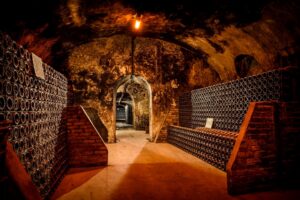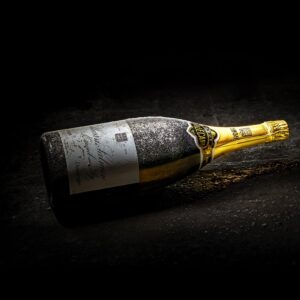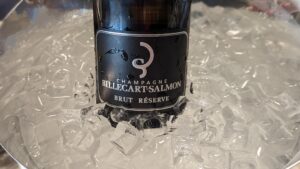It had taken five months of tasting 250 wine tanks and barrels to reach this final decision. Only a handful of wine samples made it to this all-important Champagne Billecart-Salmon blind tasting as all the backbreaking work in the vineyards, the immaculate winemaking practices and the work during several months of tasting the tanks and barrels while making exhaustive notes all come down to this moment. Eight people, representing all the essential decision makers of Billecart-Salmon – four family members that span three generations, the head of the vineyards, the assistant chief winemaker, the current chief winemaker and the former chief winemaker, come together to make a decision that will represent the highly regarded reputation of the Billecart name; a family that goes back to the ideally situated village Mareuil-sur-Aÿ, in the Champagne region in France, since the 16th century who started their own Champagne house in the 1800s.
The decision picked a key component of their Brut Réserve Champagne: the dosage.
Champagne Billecart-Salmon
Billecart-Salmon is no stranger to going beyond the call of duty to make high-quality Champagne as their long-standing meticulous practices are legendary among Champagne connoisseurs and it has given them an exceptional reputation for ages. Some of the key components that make Billecart great is their access to top vineyards within Champagne (1/3 of the vineyards they own, 1/3 they have a lease where they manage the vineyard directly and 1/3 from growers that they have worked with for decades) but some other key components in the winery and cellar make Billecart-Salmon a stellar house: fermenting in a combination of barrels and stainless steel as stainless preserves “fruit purity” as opposed to barrels which add “depth and concentration,” wines that are built to age and a “signature fermentation method” that is based on fermenting all the wines at a cold temperature that was implemented a couple of generations ago in the 1960s.

Photo Credit: Champagne Billecart-Salmon
According to the current CEO and 7th-generation family member of the Billecart-Salmon house, Mathieu Roland-Billecart, the cold fermentation is important as it preserves the “identity of the fruit character” as well as makes the actual fermenting process longer and hence, keeps the “identity of the region” with bringing out more of the sense of place, in his opinion. Also, it builds a strong “acidic backbone” in the wine and acidity with time equals “freshness and longevity.” After 60 years of employing this practice, over three generations as Mathieu’s great uncle started the cold ferment, the Billecart family has certainly perfected it.
Yet one more aspect of the Billecart process is a principal part of its excellence: the dosage.
Dosage
Dosage1 is the tiny amount of wine that tops off the Champagne bottle after disgorgement – the ejection of the sediment deposit after the second fermentation has taken place in each bottle of Champagne.
Much of the discussion around dosage surrounds the amount of sugar added in the dosage of wine as Champagne, with its traditionally cool climate, needed to take the edge off the fierce acidity. And so this is where there is a big misunderstanding, according to Mathieu Roland-Billecart. Even though Billecart-Salmon has always had a well-respected reputation when it comes to using a low amount of sugar in their dosage throughout the years (Brut Champagne allows anywhere from 0 to 12 grams per liter), there is a wide range of dosages out there, it is still a topic that Mathieu wanted to address.
“I think dosage is one of the least understood things in Champagne,” stated Mathieu as he further explained that it seems everyone makes it about sugar. And that all the Champagnes with high amounts of sugar are bad versus those with a low sugar dosage are good. But it is really about balance and the DNA of the Billecart-Salmon house is built on the foundation of finesse, elegance and balance; Mathieu said that relative to balance, finesse and elegance are easier to achieve, especially with a long legacy of prime vineyard locations and a refined approach that has been honed over centuries. He notes that despite the idea of a harmonious wine sounding like an easy task to achieve, in reality, even when one has all the outstanding components, if the right pieces are not chosen for the puzzle, then harmony and balance will not be achieved and each year there is a different puzzle to solve.
Not only does the amount of sugar change from year to year but the wine chosen from all those 250 wine tanks and barrels has to bring balance. For example, if the Billecart-Salmon Brut Réserve is mainly based on wines from the 2018 vintage, it is not just a matter of getting more 2018 to use as the dosage, as the final addition is the last chance to bring the wine to its ultimate harmony. And so Mathieu says that since he took over as CEO in 2018, they have spent just as much time on the dosage (which makes up around 20 milliliters of the bottle) as they have on the blend itself, which makes up 730 milliliters.
For a Champagne house known to go to great lengths to achieve finesse, elegance and balance, it certainly adds so much more time and energy to their process.
It’s In The DNA
Anytime one has a changing of the guard regarding another family member taking over the reins of a well-known wine legacy, it is certainly something to take notice of and to celebrate, as fewer and fewer family wine companies can pass it on to the next generation. So Mathieu thought it would be a great idea to release their 2008 vintage Champagne wines once he took over in 2018, a bicentenary year for Billecart, as it is a nice round number that represents a decade of the past in bottle that would be released on the 200th anniversary, signifying the dawn of a new era.
But as the committee tasted the 2008 vintage Champagnes as they aged on their lees, it became clear that none were ready to be released in 2018. Then it was thought that even if they had to wait a year or two, perhaps releasing a few of the 2008s all together would still be significant as there is the 2008 vintage Rosé, Blanc de Blancs and special bottlings but the wines disagreed. And so, one was released in 2021, another in 2022 and now the Cuvée Nicolas François is released in 2023.
Even though it goes against all marketing sense to release these vintage wines only when they are ready, particularly during such a momentous time, it is not in the DNA of the house of Billecart-Salmon and especially not in the DNA of Mathieu Roland-Billecart to release them too early. He has contributed to adding more time to the process to achieve excellence. Mathieu noted about the dosage, “It is not particularly a clever process, but it is a very time-consuming artisan approach,” and his family has never had any interest in showing how clever they were when it came to tasting their Champagne wines; it is about giving that ultimate experience to the drinker of the incredible place that they have safeguarded for half a millennium.
***Link to original article published in Forbes: https://www.forbes.com/sites/cathrinetodd/2023/08/30/one-of-the-biggest-misunderstandings-in-champagne-wine-addressed-by-a-top-champagne-house/
Today, each bottle of Billecart-Salmon can be traced with an origin code that shows everything about that particular Champagne bottle, starting from the vineyards to the winery and finally the cellar. One needs to look at the back of the label where “My Origin” will proceed a set of numbers that can then be placed into the web page myorigin.billecart.com to learn everything about that bottle.
NV Billecart-Salmon Brut Réserve (My Origin # 181105): The 2018 vintage makes up the base wine, with 46% reserve wines, and a blend of 36% Pinot Meunier, 32% Chardonnay and 32% Pinot Noir, with a dosage of 7.5 grams per liter. Pretty nose of lemon blossom and a saline minerality with white peach skin on the palate, hints of brioche and an incredible texture that has very fine bubbles, a touch of weight mid-palate and overall creaminess that is not too much or too little that finishes with a bright note of lemon confit.
2008 Billecart-Salmon Cuvée Nicolas François (My Origin # 081078): 83% of wines came from stainless steel and 17% came from barrel, 83% Grand Cru vineyards and 17% Premier Cru vineyards, 60% Pinot Noir and 40% Chardonnay, with a dosage of 2.9 grams per liter. 2008 was considered a superstar year with a fantastic combination of beautiful fruit and high acidity and one can see why in this 2008 Nicolas François, named after the founder of Champagne Billecart-Salmon. The nose beckons with delicately enticing notes of honeysuckle and lemon pastry with hints of lilacs in the background that has marked acidity and an intense energy on the palate that is simply breathtaking, with a chalky minerality on the long, expressive finish.
1998 Billecart-Salmon Cuvée Nicolas François: Mathieu wanted to show a Champagne with a lot more age to display the incredible longevity that Billecart is known for yet he also wanted to show a vintage known for its ripeness and how the fresh style of Billecart keeps such a vintage still vibrant even at 25 years of age. The fruit is still vivid with juicy nectarine with touches of marzipan and lemon meringue that are intermixed with orange zest and toasted spices on the palate, concentrated with fresh fruit yet bright acidity and a broad, rich finish with lots of lift.
Footnote:
1 Dosage technically is the sugar added to the wine that tops off the Champagne bottle after disgorgement, and this additional wine with the added sugar is technically called liqueur d’expédition. But many in the wine business will just use the terms dosage liqueur or simply dosage (French pronunciation: do zaj) instead of liqueur d’expédition, and hence, it is referred to in this article as dosage.
















